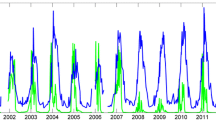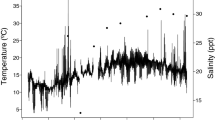Abstract
Respiration rates of Thais haemastoma and Callinectes sapidus were determined as a function of salinity with a flow-through respirometer at 20°C. Respiration rates were measured at 10, 20 and 30‰ S for acclimated animals. The effects of 10-5-10‰, 20-10-20‰, 30-10-30‰ and 10-30-10‰ S semidiurnal cycles (12 h) of fluctuating salinity on the rate of respiration of the oyster drill were studied. During each cycle, salinity was changed from the acclimation salinity over a 4 h interval, held at that salinity for 2 h, returned to the acclimation salinity over 4 h and held at that salinity for 2 h. The effects of diurnal (24.8 h) salinity cycles on respiration in the oyster drill and blue crab were also studied. Salinity was changed from the acclimation salinity over a 10.4 h interval, held at that salinity for 2 h, then returned to the acclimation salinity over 10.4 h and held at that salinity for 2 h. The respiration rate of 30‰ S acclimated oyster drills (679 μl O2 g dry weight−1 h−1) was significantly higher than for individuals acclimated to 10‰ S (534 μl O2 g dry weight−1 h−1). Blue crab respiration was 170 μl O2 g dry weight−1 h−1 at 30‰ S, and was significantly higher at 10 and 20‰ S than at 30‰ S. With the exception of the 20-10-20‰ S semidiurnal cycle, the respiration rate of oyster drills declined as salinity fluctuated in either direction from the acclimation salinity and increased as ambient salinity returned to the acclimation salinity. Semidiurnal cycles (12 h) of fluctuating salinity produced greater changes in the respiration rate of snails than analogous diurnal cycles (24.8 h). A 10-30-10‰ S pattern of fluctuation caused a greater percentage reduction in the steady state respiration rate of oyster drills than the 30-10-30‰ S pattern. The respiration rate of blue crabs varied inversely with fluctuating salinity. Relatively minor changes occurred in blue crab respiration rate with fluctuating salinity. Blue crab respiration rate characteristically dropped during the initial phase of declining salinity at a rate directly proportional to the rate of salinity decrease, perhaps representing a metabolic adjustment period by the blue crabs. The respiratory response of T. haemastoma to salinity is consistent with its incomplete volume regulation, while the response of C. sapidus is compatible with its ability to regulate extracellular fluid osmotic and ionic composition.
Similar content being viewed by others
Literature Cited
Davenport, J.: A comparative study of the behavior of some balanomorph barnacles exposed to fluctuating seawater concentrations. J. mar. biol. Ass. U.K. 56, 889–907 (1976)
—: A study of the effects of copper applied continuously and discontinuously to specimens of Mytilus edulis (L.) exposed to steady and fluctuating salinity levels. J. mar. biol. Ass. U.K. 57, 63–74 (1977)
—, Ll. D. Gruffydd and A.R. Beaumont: An apparatus to supply water of fluctuating salinity and its use in a study of the salinity tolerance of the larvae of the scallop Pecten maximus L. J. mar. biol. Ass. U.K. 55, 391–409 (1975)
Engel, D.W. and L.D. Eggert: The effects of salinity and sex on the respiration rates of excised gills of the blue crab, Callinectes sapidus. Comp. Biochem. Physiol. 47A, 1005–1011 (1974)
— and C.D. Nichols: A method for continuous in vivo measurement of hemolymph conductivity in crabs. J. exp. mar. Biol. Ecol. 26, 203–209 (1977)
Findley, A.M. and W.B. Stickle: Effects of salinity fluctuation on the hemolymph composition of the blue crab Callinectes sapidus. Mar. Biol. 46, 9–15 (1978)
Hand, S.C. and W.B. Stickle: Effects of tidal fluctuations of salinity on pericardial fluid composition of the American oyster Crassostrea virginica. Mar. Biol. 42, 259–271 (1977)
Hume, R.I. and H. Berlind: Heart and scaphognathite rate changes in a euryhaline crab, Carcinus maenas, exposed to dilute environmental medium. Biol. Bull. mar. biol. Lab., Woods Hole 150, 241–254 (1976)
King, E.N.: The oxygen consumption of intact crabs and excised gills as a function of decreased salinity. Comp. Biochem. Physiol. 15, 93–102 (1965)
Kinne, O.: Salinity: animals—invertebrates. In: Marine ecology. Vol. 1. Environmental factors, Part 2. pp 821–995. Ed. by O. Kinne. New York: Wiley-Interscience 1971
Laird, C.E. and P.A. Haefner, Jr.: Effects of intrinsic and environmental factors on oxygen consumption in the blue crab, Callinectes sapidus Rathbun. J. exp. mar. Biol. Ecol. 22, 171–178 (1976)
Motwani, M.P.: Experimental and ecological studies on the adaptation of Mytilus edulis L. to salinity fluctuations. Proc. natn. Inst. Sci. India (Ser. B) 21, 227–246 (1955)
Pierce, S.K., Jr.: Volume regulation and valve movements by marine mussels. Comp. Biochem. Physiol. 39A, 103–117 (1971)
Potts, W.T.W. and G. Parry: Osmotic and ionic regulation in animals, 423 pp. New York: The Macmillan Company 1964
Schlieper, C.: Physiology of brackish water. Part II. In: Biology of brackish water, Second ed., pp 211–350. Ed. by A. Remane and C. Schlieper. New York: Wiley-Interscience 1971
Service, J.: A users guide to the statistical analysis system, 260 pp. Raleigh, North Carolina: North Carolina State University Student Supply Store 1972
Shumway, S.E.: The effects of fluctuating salinities on four species of asteroid echinoderms. Comp. Biochem. Physiol. 58A, 177–179 (1977a)
—: The effect of salinity fluctuation on the osmotic pressure and Na+, Ca2+ and Mg2+ ion concentrations in the hemolymph of bivalve molluscs. Mar. Biol. 41, 153–177 (1977b)
—: The effect of fluctuating salinity on the tissue water content of eight species of bivalve molluscs. J. comp. Physiol. 116, 269–285 (1977c)
— and J. Davenport: Some aspects of the physiology of Arenicola marina L. exposed to fluctuating salinities. J. mar. biol. Ass. U.K. 57, 907–924 (1977)
Shumway, S.E., P.A. Gabbott and A. Youngson: The effect of fluctuating salinity on the concentrations of free amino acids and ninhydrin positive substances in the adductor muscles of eight species of bivalve molluscs. J. exp. mar. Biol. Ecol. (In press). (1978)
Steel, R.G.D. and D.H. Torrie: Principles and procedures of statistics, 481 pp. New York: McGraw-Hill 1960
Stickle, W.B.: Some physiological aspects of the reproductive cycle of the intertidal prosobranch Thais lamellosa Gmelin, 1792, 160 pp. Ph.D. Thesis, University of Saskatchewan, Regina Campus 1970
— and R. Ahokas: The effects of tidal fluctuations of salinity on the perivisceral fluid of several echinoderms. Comp. Biochem. Physiol. 47A, 469–476 (1974)
——: The effects of tidal fluctuation of salinity on the hemolymph composition of several molluscs. Comp. Biochem. Physiol. 50A, 291–296 (1975)
— and D.J. Denoux: Effects of in situ tidal salinity fluctuations on osmotic and ionic composition of body fluid in Southeastern Alaska rocky intertidal fauna. Mar. Biol. 37, 125–135 (1976)
— and T.W. Howey: Effects of tidal fluctuations of salinity on hemolymph composition of the southern oyster drill Thais haemastoma. Mar. Biol. 33, 309–322 (1975)
Strickland, J.D.H. and T.R. Parsons: A practical handbook of seawater analysis. Bull. Fish. Res. Bd Can. 167, 1–311 (1968)
Taylor, A.C.: The respiratory response of Carcinus maenas (L.) to changes in environmental salinity. J. exp. mar. Biol. Ecol. 29, 197–210 (1977)
Taylor, E.W., P.J. Buler and A. Al-Wassia: The effects of a decrease in salinity on respiration, osmoregulation and activity in the shore crab, Carcinus maenas (L.) at different acclimation temperatures. J. comp. Physiol. 119, 155–170 (1977)
Tucker, L.E.: Effects of external salinity on Scutus breviculus (Gastropoda, Prosobranchia)-1. Body weight and blood composition. Comp. Biochem. Physiol. 36, 301–309 (1970a)
— Effects of external salinity on Scutus breviculus (Gastropoda, Prosobranchia)-11. Nerve conduction. Comp. Biochem. Physiol. 37, 467–480 (1970b)
Zachary, A. and D.S. Haven: Survival and activity of the oyster drill Urosalpinx cinerea under conditions of fluctuating salinity. Mar. Biol. 22, 45–52 (1973)
Author information
Authors and Affiliations
Additional information
Communicated by J.M. Lawrence, Tampa
Rights and permissions
About this article
Cite this article
Findley, A.M., Belisle, B.W. & Stickle, W.B. Effects of salinity fluctuations on the respiration rate of the southern oyster drill Thais haemastoma and the blue crab Callinectes sapidus . Mar. Biol. 49, 59–67 (1978). https://doi.org/10.1007/BF00390730
Accepted:
Issue Date:
DOI: https://doi.org/10.1007/BF00390730




